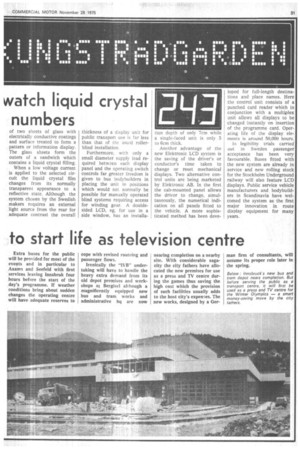Swedes watch liquid crystal numbers route
Page 32

Page 33

If you've noticed an error in this article please click here to report it so we can fix it.
A novel method of displaying route numbers and destinations on public service vehicles and rapid transit rolling stock has been developed in Sweden by Elektronic AB, of Jarfalla. The system involves the first commercial application of liquid crystal displays to form letters and digits up to 25cm high.
Liquid crystal displays (LCD) of this type are to be incorporated in a new range of destination indicator units to be announced next year by a leading British specialist in this field. LCD basically consist of two sheets of glass with electrically conductive coatings and surface treated to form a pattern or information display. The glass sheets form the outers of a sandwich which contains a liquid crystal filling.
When a low voltage current is applied to the selected circuit the liquid crystal film changes from its normally transparent appearance to a reflective state. Although the system chosen by the Swedish makers requires an external light source from the rear for adequate contrast the overall thickness of a display unit for public transport use is far less than that of the usual rollerblind installation.
Furthermore, with only a small diameter supply lead required between each display panel and the operating switch controls far greater freedom is given to bus bodybuilders in placing the unit in positions which would not normally be possible for manually operated blind systems requiring access for winding gear. A doublesided LCD, eg, for use in a side window, has an installa tion depth of only 7cm while a single-faced unit is only 5 to 6cm thick.
Another advantage of the new Elektronic LCD system is the saving of the driver's or conductor's time taken to change or reset mechanical displays. Two alternative control units are being marketed by Elektronic AB. In the first the cab-mounted panel allows the driver to change, simultaneously, the numerical indication on all panels fitted to the vehicle. A more sophisticated method has been deve loped for full-length destinations and place names. Here the control unit consists of a punched card reader which in conjunction with a multiplex unit allows all displays to be changed :instantly on insertion of the programme card. Operating life of the display elements is around 50,000 hours.
In legibility trials carried out in Sweden passenger acceptance has been very favourable. Buses fitted with the new system are already in service and new rolling stock for the Stockholm Underground railway will also feature LCD displays. Public service vehicle manufacturers and bodybuilders in Scandinavia have welcomed the system as the first major innovation in route display equipment for many years.




































































